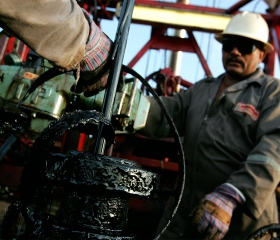Only a few believed that the meeting of oil producers held in Doha on April 17, 2016 would be so futile. It was largely due to the unyielding stance of Saudi Arabia that the participating countries failed to reach an agreement and left without any prospects of holding another round of talks. The document freezing oil production at the January 2016 level that was developed by experts from Russia, Saudi Arabia, Venezuela and Qatar and which is set to expire this October, was cancelled by Riyadh.
Only a few believed that the meeting of oil producers held in Doha on April 17, 2016 would be so futile. It was largely due to the unyielding stance of Saudi Arabia that the participating countries failed to reach an agreement and left without any prospects of holding another round of talks. The document freezing oil production at the January 2016 level that was developed by experts from Russia, Saudi Arabia, Venezuela and Qatar and which is set to expire this October, was cancelled by Riyadh, despite months of consultations that preceded the talks. From a formal point of view, Saudi Arabia did not act unilaterally ― it was joined by Qatar, the United Arab Emirates and Kuwait. And still, the Doha summit revived the OPEC cooperation mechanisms, where the undisputed leader (Saudi Arabia) imposes its will on the other Persian Gulf states and refuses to coordinate its moves with the other members of the oil club.
Iran, which skipped the talks, became the stumbling block. The country formally supported the oil production freeze, but promised to join the move only after it had reached its pre-sanctions capacity. It should be noted that before the European Union imposed the oil embargo in January 2012, Iran’s daily crude production capacity stood at 3.7 million barrels. Following the inevitable drop in 2012–2015, Iran managed to promptly boost output to 3.5 million barrels a day, which is very close to the pre-sanctions level. Nevertheless, Tehran will not confine itself to the goals voiced prior to the oil summit, as the Ministry of Petroleum of Iran was tasked with hitting the 4 million barrels target in the shortest time possible, regardless of the world price.
The lack of progress had a number of consequences for the world economy. All attempts to coordinate oil production made by the world energy leaders in recent months were frustrated by cancelling the clause on fixing production at the January level. Thus, all oil producers may act at their discretion and, taking into account Saudi Arabia’s refusal to live by the OPEC quotas announced in December 2014, as of today there is not a single, not even an optional, format ensuring the coordination of energy policy among oil producers. By no means does this suggest that a similar forum cannot convene in the future. But the level of trust, both within OPEC as well as among the members of the oil club and non-member states, is extremely low. This much is clear from the statement made by Minister of Energy of the Russian Federation Alexander Novak, who believes that coordination is possible in future: “we will not be so optimistic about these agreements anymore”.
Most analysts expected the Doha meeting to be crowned with the January agreements being locked in, albeit vaguely worded and with no significant concessions being made by participants. With crude production in Russia and Saudi Arabia reaching its peak in January 2016, setting limits did not entail any missed opportunities. Still, the Doha agreements of February 16, 2016 became a signal letting the oil players know that the situation is under control and the key producers, who have all been affected by the low prices, will take steps to prevent panic in the market.
Despite lack of coordination of producers’ energy policies, the volatility in the market will be temporary. On April 18, after the Doha failure was announced, the Brent oil benchmark dropped 6 per cent to $40 a barrel, though it later improved. Prices are unlikely to fall below $35 a barrel in the coming weeks, as there are factors which prevent panic from creeping into the market. For instance, oil workers in Kuwait (OPEC’s third largest producer) began an open-ended strike on April 17 to protest proposed cuts in their wages, benefits and incentives. The strike has already slashed daily crude production by more than 60 per cent as of in April 2016 to 1.1 million barrels.
According to the International Energy Agency, as well as several analytical centres, the world oil market will reach a point at which supply and demand will be more or less in balance in the first half of 2017. The traditional growth of demand in the second half of 2016 will contribute to that, exceeding the first half indicators by some 1.5 million barrels per day. Taking into account the current oversupply of 1.3–1.4 million barrels per day, this would be enough to reach excessive demand. However, the growing Iranian output, coupled with the stabilization of the situation in Nigeria (and possibly Libya), will put an obstacle to reaching the balance in 2016.
Oil production will face drops throughout 2016, mostly outside OPEC. Russia, which seems to have become used to new pricing realities, is an exception. The first quarter daily crude production hit a record high of 10.9 million barrels, and despite the possible reduction in the second half of 2016, output is very likely to exceed the 2015 figures. Yet, the Doha failure makes the short-term situation in Russia’s economy more complex: the rouble will partially lose its sensitive positions, and budget revenues will drop. Russia has joined OPEC initiatives on several occasions in the past, (e.g., during the 1998 market collapse, or the 2008 crisis), only to ignore reaching the promised quotas later on. The Kremlin’s current goal to reach an agreement is different than before. This is because the country, which is engulfed in the conflict in the Middle East and is facing financial and economic sanctions and other destabilizing phenomena, still has something to lose. However, prioritizing geopolitical factors in the energy sector, including the failure to settle the Saudi Arabia–Iran confrontation in the Middle East, testifies to the fact that the best energy policy should be turned inwards, towards gaining the maximum competitive advantage.






